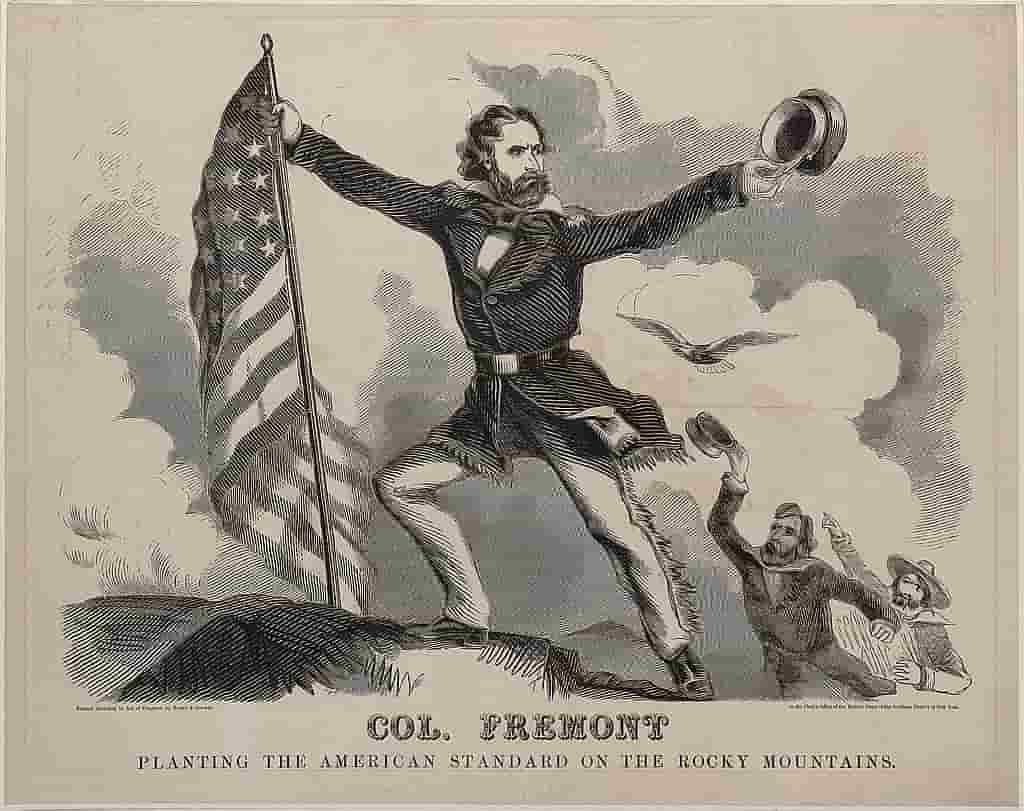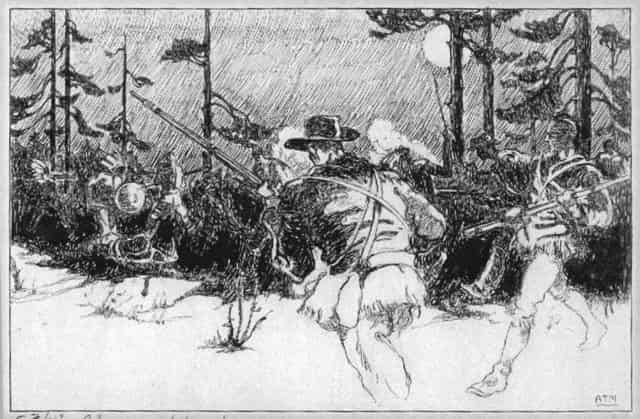
John C. Frémont: General, Explorer, and Entrepreneur
John Frémont, explorer of the West, made his fortunes in the gold fields of California but lost everything in his investments in railroads like the Cincinnati Railway Tunnel Company.
Header Image: John C. Frémont stands on a mountain top with a flag in this presidential campaign poster; author Baker & Godwin courtesy Wikimedia Commons [1].
“Railroads followed the lines of his journeying, a nation followed his maps to their resting place, and cities have risen on the ashes of his campfires.”

John C. Frémont fights with Native Americans; artist Arman Manookian; courtesy Wikimedia Commons
This certificate for stock in the Cincinnati Railway Tunnel Company has been signed on the back by John C. Frémont, famous explorer of the western United States. Frémont led three expeditions to explore and survey the American West in the 1840s. His party traveled through northwestern Nevada in 1844; Frémont was responsible for naming Pyramid Lake after discovering and mapping it and crossed the Sierra Nevada Mountains with Kit Carson serving as his guide. The Frémont party had brought a howitzer cannon along on the expedition, but it is believed that they abandoned it in a snow drift while crossing the Sierra Nevada.
Over a century later, in 1970, a replica of the cannon was built as a trophy of the UNR-UNLV football rivalry. The winning team gained possession of the cannon and would fire the cannon after each of their team’s touchdowns. While the cannon has been damaged and no longer fires, it remains a symbol of the universities’ rivalry. The University of Nevada’s Wolfpack has maintained dominance in this rivalry, holding a 25-17 record against the UNLV Rebels.
After exploring Nevada, Frémont embarked on his third expedition as conflict was brewing between the United States and Mexico. He became involved in the Bear Flag Revolt, which briefly established an American-held government in California, and ultimately led to his court-martial for mutiny and resignation from the army. Still, his reputation remained strong, and Frémont became wealthy during the Gold Rush after gold ore veins were discovered on his California property. He became one of California’s first two senators in 1850, and in 1856 was nominated as the newly-formed Republican party’s first presidential candidate. He lost to James Buchanan, but soon led Union troops in the American Civil War. Again, he proved to be a weak military leader and resigned from the army. (Scroll down to continue reading about the Cincinnati Railway Tunnel Company below)
In the period following the Civil War, Frémont devoted his efforts to the expansion of our nation’s railroad system and invested his millions in railroad projects. However, the railroad industry was experiencing a speculative bubble in the postwar period, and over-investment in the industry proved risky. When the bubble burst, it contributed to the financial Panic of 1873, which was known as the “Great Depression” at the time. One can see how Frémont lost his fortunes in the Panic of 1873, as much of wealth was wrapped up railroad schemes like this investment in fifty shares of the Cincinnati Railway Tunnel Company, bought at $100 a share—$5,000, a hefty sum for the era—and this is only one of dozens of certificates for stock he owned in this particular company.
The Cincinnati Railway Tunnel Company struggled for several years before being absorbed into a larger railroad company. Frémont also struggled with destitution, but still served as Governor of the Arizona Territory until 1883. He passed away in 1890 at the age of 77.
 University of Nevada, Reno
University of Nevada, Reno
